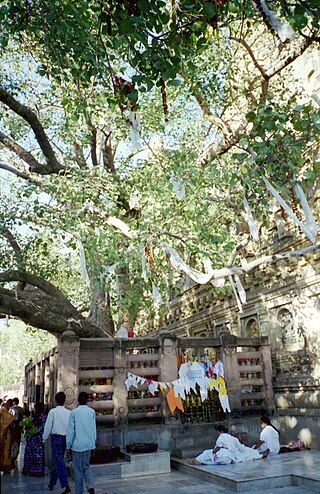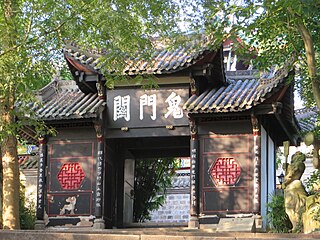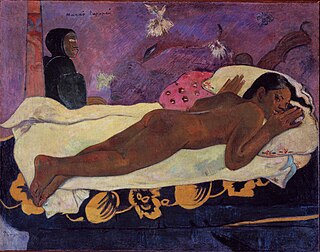Related Research Articles

In folklore, a ghost is the soul or spirit of a dead person or non-human animal that is believed to be able to appear to the living. In ghostlore, descriptions of ghosts vary widely, from an invisible presence to translucent or barely visible wispy shapes to realistic, lifelike forms. The deliberate attempt to contact the spirit of a deceased person is known as necromancy, or in spiritism as a séance. Other terms associated with it are apparition, haunt, haint, phantom, poltergeist, shade, specter, spirit, spook, wraith, demon, and ghoul.

Halloween or Hallowe'en is a celebration observed in many countries on 31 October, the eve of the Western Christian feast of All Hallows' Day. It is at the beginning of the observance of Allhallowtide, the time in the liturgical year dedicated to remembering the dead, including saints (hallows), martyrs, and all the faithful departed. In popular culture, the day has become a celebration of horror, being associated with the macabre and supernatural.

The veneration of the dead, including one's ancestors, is based on love and respect for the deceased. In some cultures, it is related to beliefs that the dead have a continued existence, and may possess the ability to influence the fortune of the living. Some groups venerate their direct, familial ancestors. Certain religious groups, in particular the Eastern Orthodox Churches and the Catholic Church, venerate saints as intercessors with God; the latter also believes in prayer for departed souls in Purgatory. Other religious groups, however, consider veneration of the dead to be idolatry and a sin.
In Hawaiian religion, Hiʻiaka is a daughter of Haumea and Kāne.
In the Hawaiian religion, Wākea, the Sky father weds Papahānaumoku, the earth mother. The two are considered the parent couple of the ruling chiefs of Hawaii.

Kahoʻolawe, anglicized as Kahoolawe, is the smallest of the eight main volcanic islands of the Hawaiian Islands. Unpopulated, it lies about seven miles (11 km) southwest of Maui. The island is 11 mi (18 km) long by 6.0 mi (9.7 km) wide, with a total land area of 44.97 sq mi (116.47 km2). Its highest point is the crater of Lua Makika, at the summit of Puʻu Moaulanui, about 1,477 feet (450 m) above sea level.

The Well of Souls, is a partly natural, partly man-made cave located inside the Foundation Stone under the Dome of the Rock shrine on the Temple Mount in Jerusalem. During the Crusader period, it was known to Christians as the "Holy of Holies", referring to the inner sanctum of the former Jewish Temple, which, according to modern scholarship, was probably located on top of the Foundation Stone.
In Hawaiian mythology, Nightmarchers or Spirit Ranks (ʻoiʻo) are the deadly ghosts of ancient tribal Hawaiian warriors. The nightmarchers are the vanguard for a sacred king, chief or chiefess.

Moanalua is a valley, a stream, an ahupuaʻa, and a residential neighborhood in Honolulu, Hawaiʻi. The valley extends inland from behind Āliapaʻakai crater to the crest of the Koʻolau Range.

Puʻuhonua o Hōnaunau National Historical Park is a United States National Historical Park located on the west coast of the island of Hawaiʻi in the U.S. state of Hawaii. The historical park preserves the site where, up until the early 19th century, Hawaiians who broke a kapu could avoid certain death by fleeing to this place of refuge or puʻuhonua. The offender would be absolved by a priest and freed to leave. Defeated warriors and non-combatants could also find refuge here during times of battle. The grounds just outside the Great Wall that encloses the puʻuhonua were home to several generations of powerful chiefs.

In Celtic mythology, the Otherworld is the realm of the deities and possibly also the dead. In Gaelic and Brittonic myth it is usually a supernatural realm of everlasting youth, beauty, health, abundance and joy. It is described either as a parallel world that exists alongside our own, or as a heavenly land beyond the sea or under the earth. The Otherworld is usually elusive, but various mythical heroes visit it either through chance or after being invited by one of its residents. They often reach it by entering ancient burial mounds or caves, or by going under water or across the western sea. Sometimes, they suddenly find themselves in the Otherworld with the appearance of a magic mist, supernatural beings or unusual animals. An otherworldly woman may invite the hero into the Otherworld by offering an apple or a silver apple branch, or a ball of thread to follow as it unwinds.

Cordyline fruticosa is an evergreen flowering plant in the family Asparagaceae. The plant is of great cultural importance to the traditional animistic religions of Austronesian and Papuan peoples of the Pacific Islands, New Zealand, Island Southeast Asia, and Papua New Guinea. It is also cultivated for food, traditional medicine, and as an ornamental for its variously colored leaves. It is identified by a wide variety of common names, including ti plant, palm lily, cabbage palm.

Trees are significant in many of the world's mythologies, and have been given deep and sacred meanings throughout the ages. Human beings, observing the growth and death of trees, and the annual death and revival of their foliage, have often seen them as powerful symbols of growth, death and rebirth. Evergreen trees, which largely stay green throughout these cycles, are sometimes considered symbols of the eternal, immortality or fertility. The image of the Tree of life or world tree occurs in many mythologies.

Waipiʻo Valley is a valley located in the Hamakua District of the Big Island of Hawaiʻi. "Waipiʻo" means "curved water" in the Hawaiian language.

Kapu Kuʻialua; Kuʻialua; or Lua; is an ancient Hawaiian martial art based on bone breaking, joint locks, throws, pressure point manipulation, strikes, usage of various weapons, battlefield strategy, open ocean warfare as well as the usage of introduced firearms from the Europeans.

The gates of hell are various places on the surface of the world that have acquired a legendary reputation for being entrances to the underworld. Often they are found in regions of unusual geological activity, particularly volcanic areas, or sometimes at lakes, caves, or mountains.

Hawaiian religion refers to the indigenous religious beliefs and practices of native Hawaiians, also known as the kapu system. Hawaiian religion is based largely on the tapu religion common in Polynesia and likely originated among the Tahitians and other Pacific islanders who landed in Hawaiʻi between 500 and 1300 AD. It is polytheistic and animistic, with a belief in many deities and spirits, including the belief that spirits are found in non-human beings and objects such as other animals, the waves, and the sky. It was only during the reign of Kamehameha I that a ruler from Hawaii island attempted to impose a singular "Hawaiian" religion on all the Hawaiian islands that was not Christianity.

There was widespread belief in ghosts in Polynesian culture, some of which persists today. After death, a person's ghost would normally travel to the sky world or the underworld, but some could stay on earth. In many Polynesian legends, ghosts were often involved in the affairs of the living. Ghosts might also cause sickness or even invade the body of ordinary people, to be driven out through strong medicines.

Leina Kauhane is white rock located approximately 0.4 mi (0.64 km) offshore on the northwest area of the Hawaiian island Oahu. It is noted in Hawaiian folklore as the point where souls of the dead journey into the afterlife (Lua-o-Milu) and overlooks the ocean. The term Rienga is used in New Zealand and is considered to parallel this concept. Suitably, within their belief system, the Marquesans applied it to the northernmost island of their region as well.
According to ancient Hawaiian myth, Milu is the god of the dead and ruler of Lua-o-Milu. He is now thought to share analogs with Hades. Under his command, are a host of beings known as spirit catchers who would trap wandering ghosts and bring them to his afterlife domain. In one legend, a chief harrowed of the loss of his wife, has his prayers answered and receives guidance from a deity who shows him the way into Milu's kingdom. They journey far out and find a tree split in two. Next they slide down it into the Earth's lower regions. Here, the deity hid behind a rock and covered the chief with odd smelling oil then sent him out by himself. Once the chief found Milu's palace, he noticed a group of spirits who were so distracted in the game they were playing, he was able to join, and luckily, when they did realize he was near them, they mistook him for a stinking ghost. When the crowd was finished, they wanted to play another game, hence the chief proposed they should all pull their eyes out and paid his attention to those belonging to Milu. He later caught them in a coconut cup and blinded the god. Now he was able to escape to Wākea's heaven, where the Underworld's inhabitants could not set foot. Eventually a deal was made and Milu's eyes were returned, on the condition that the chief's wife's soul be brought back.
References
- ↑ Beckwith, Martha Warren (1976). Hawaiian Mythology. University of Hawaii Press. ISBN 9780824805142.
- ↑ Thrum, Thomas (1907). Hawaiian Folk Tales. A. C. McClurg. p. 12.
- ↑ Smith, Robert (1980). Hiking Oahu, the Capital Isle. Wilderness Press. p. 108. ISBN 9780899970066.